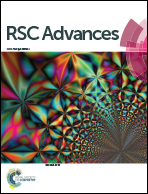Zn2+ removal from the aqueous environment using a polydopamine/hydroxyapatite/Fe3O4 magnetic composite under ultrasonic waves†
Abstract
In this study, an easily magnetically recoverable polydopamine (PDA)-modified hydroxyapatite (HAp)/Fe3O4 magnetic composite (HAp/Fe3O4/PDA) was suitably synthesized to exploit its adsorption capacity to remove Zn2+ from aqueous solution, and its structural properties were thoroughly examined using different analytical techniques. The effect of multiple parameters like pH, ultrasonic power, ultrasonic time, adsorbent dose, and initial Zn2+ concentration on the adsorption efficiency was assessed using RSM-CCD. According to the acquired results, by increasing the adsorbent quantity, ultrasonic power, ultrasonic time, and pH, the Zn2+ adsorption efficiency increased and the interaction between the variables of ultrasonic power/Zn2+ concentration, pH/Zn2+ concentration, pH/absorbent dose, and ultrasonic time/adsorbent dose has a vital role in the Zn2+ adsorption. The uptake process of Zn2+ onto PDA/HAp/Fe3O4 followed Freundlich and pseudo-second order kinetic models. The maximum capacity of Zn2+ adsorption (qm) obtained by PDA/HAp/Fe3O4, HAp/Fe3O4, and HAp was determined as 46.37 mg g−1, 40.07 mg g−1, and 37.57 mg g−1, respectively. Due to its good performance and recoverability (ten times), the HAp/Fe3O4/PDA magnetic composite can be proposed as a good candidate to eliminate Zn2+ ions from a water solution.



 Please wait while we load your content...
Please wait while we load your content...